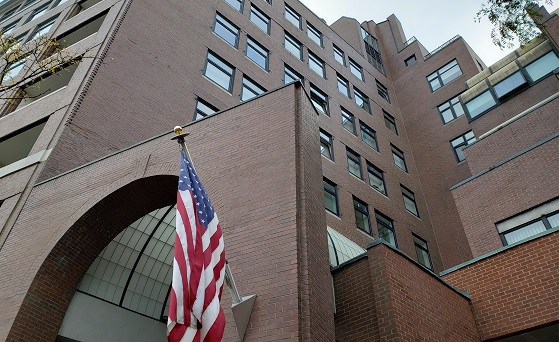Silicone has a very different chemistry than other materials; it is made with a silicon-oxygen chemical backbone instead of the carbon-carbon linkage associated with most other rubber types. Furthermore, the silicone-oxygen-silicone bond is inherently much more flexible and has a higher “bond” length than the carbon-carbon linkages.
It is this fundamental difference that gives silicone its unique combination of outstanding properties: ultraviolet (UV) stability, low-temperature flexibility, high-temperature stability, seismic-capable flexibility, durability, and flammability resistance. These were all among the properties that led to silicone becoming the material chosen for the boots worn on the maiden moon landing.
Products made from silicone, which is derived from the inorganic element silicon, are ideal candidates for exterior-facing construction applications such as joint sealants, coatings, and structural glazing adhesives due to their excellent long-term resistance to weathering and their ability to maintain their properties for very long periods of time. There are numerous real-world uses of silicones in exterior applications that are still performing more than 40 years after installation.
Silicone Coatings
Putting silicone’s outstanding properties to work in a coating formulation can result in some important and differentiated performance benefits to a building. Buildings are designed and built to protect against unintended water infiltration; but movement, aging, design or construction defects, and/or a number of other conditions can lead to water intrusion problems. In turn, this can lead to energy loss, corrosion, mold, water damage, and other undesirable effects. Billions of dollars are spent every year around the world trying to combat water intrusion into buildings.
A silicone coating can prevent liquid water and air from permeating through the façade while simultaneously allowing moisture vapor to exit, rather than condense, on the inside and lead to water issues. This can occur because of the size of water, vapor, and air molecules, as well as the low surface energy of silicone.

Think of a jar filled with marbles. Golf balls (acting as liquid water, air currents, etc.) won’t sink through those marbles because they are too large, but sand (acting as oxygen, water vapor, etc.) will be able to slowly find its way between the marbles due to its smaller size. Similarly, the higher bond length between silicon and oxygen atoms ensures more “empty” space between the polymer chains of a silicone coating, which effectively creates an “interstate highway” for water vapor molecules to travel across, compared to the much narrower pathways available in organic polymers.
All of these properties combine to allow a silicone coating to protect a building for decades without fundamentally changing the building science of the façade.
Masonry Challenges
Masonry is typically a very resilient material when used in building façades. The primary disadvantages of these materials are: (1) inflexibility, which can lead to cracks due to building movement; and (2) porosity, which allows absorption and diffusion of a portion of the water that it is exposed to, rather than repelling that water. As such, the cladding is, therefore, not usually intended as the primary waterproof barrier.
Typical modern cavity wall construction manages water through waterproofing inside the wall cavity with provisions (e.g., weeps, flashing, etc.) in the masonry cladding for the water to exit. However, if the waterproofing fails, removal/repair of the cladding to address the problem can be an invasive and extremely costly approach.
What makes these designs different is that, with other types of cladding — such as external insulation and finishing systems (EIFS) or stucco — an opaque tinted elastomeric coating can be used essentially to move the waterproof barrier to the building’s exterior, delivering a viable, cost-effective solution. However, in the case of masonry, the desire to maintain the natural aesthetics often precludes the use of opaque coatings. Instead, a clear silicone coating can provide a cost-effective and long-term solution to water intrusion issues without sacrificing appearance.
That is the solution that was chosen for the Mariner, a luxury condominium complex in Boston. The brick building is in the city’s historic North End facing Boston Harbor, which meant that the look of the exterior’s final finish helped determine the chosen waterproofing solution. Read the full article in the November issue of CoatingsPro.
About the Author
Errol Bull is the technical manager, Construction Products, North America, at Momentive Performance Materials, Inc. Errol provides technical support based on 21 years of global experience in construction sealants, adhesives, and coatings. For more information, contact: Momentive, www.siliconeforbuilding.com
